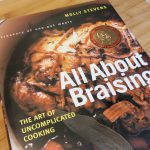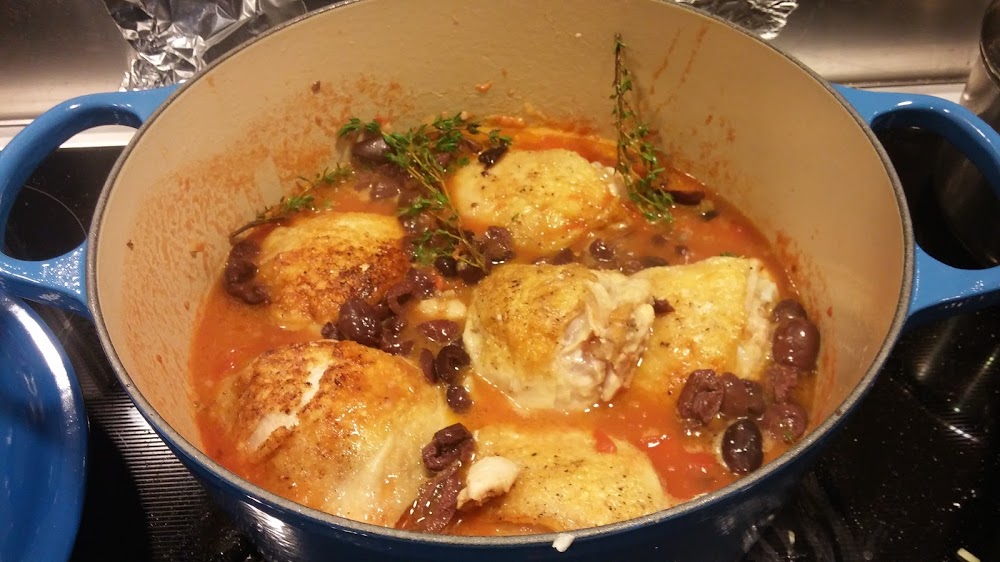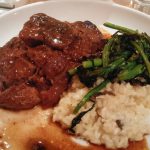When it’s been this cold, there’s no kitchen aroma more welcoming, warming, and enticing than a slowly simmering braise. Beef and red wine, pork and dried fruits, chicken and tomatoes, the combinations are limitless and ideal to keep us nourished through the depths of winter.
Pot roast is the all-American braise, a staple of home kitchens and family restaurant menus for generations: a slab of darkly browned beef chuck surrounded with aromatic vegetables swimming in red wine – all slowly simmering in the oven. Meltingly tender slices covered in rich gravy and surrounded by root vegetables – it doesn’t get any better than that.
Braising takes a little time, but the rewards are worth it. Get everything ready, sear the meat for deep flavor and set it all to simmer in the pot. In the oven or on top of the stove, a gentle simmer with plenty of liquid yields rich flavors and tender meat.
 In her award-winning book, All About Braising, classically trained chef Molly Stevens says, “Braising produces food that draws people together. The concentrated aromas, tender textures, and deep flavors set people at ease, and braising is easy on the cook.” Indeed, all the work is done ahead. The braise comes out of the pot, magically ready to serve.
In her award-winning book, All About Braising, classically trained chef Molly Stevens says, “Braising produces food that draws people together. The concentrated aromas, tender textures, and deep flavors set people at ease, and braising is easy on the cook.” Indeed, all the work is done ahead. The braise comes out of the pot, magically ready to serve.
Her recipe for Pork Pot Roast with Apricots, Cardamom and Ginger is one of my favorites. Dried apricots become puddles of sweet flavor. Exotic ginger and cardamom along with turmeric, cloves, cayenne, and orange zest bring the flavors of far away places. A fatty pork shoulder becomes fork tender by simmering in stock and white wine. It’s a knockout dish and even better the day after.
You don’t always need a recipe for a braise. For pot roast, I often wing it. A couple of strips of bacon is a good beginning. The smoky, salty fat that renders out is great for browning the beef and then wilting the onions, carrots, and celery. When the vegetables are tender, put the meat back in the pot along with the cooked bacon, add the better part of a bottle of red wine (not your best), and maybe a little beef stock (store bought is OK). Sometimes I add a handful of dried cranberries for a mysterious hint of fruity sweetness. No tomatoes for me. Put the pot in the oven at 325° for about three hours. The house will smell wonderful and the dinner will be delicious.
Brisket is favored by some for a pot roast, but I like chuck. Cut from the shoulder, it has fat marbling for flavor and gristle which melts into silky richness. It’s a tough cut that requires a long slow braise, but it’s loaded with flavor as the tough cuts usually are. Round steak, which is sometimes labeled as pot roast, is too lean to make a good braise. Dry and cottony when cooked, it just doesn’t cut it for me.
Chicken makes a quick braise. We have a few favorites that are in regular rotation. Thighs are the most forgiving for braising. They won’t dry out like white meat and will stay moist even if you’re ahead of schedule and have to hold them for a while.
 A few years ago I came across Mark Bittman’s recipe for Braised Chicken With Tomatoes, Olives and Capers in the New York Times. With only 8 ingredients, mostly kitchen staples, it’s a crowd pleaser that’s easy to pull together at the last minute. I use chicken thighs instead of a whole chicken. Some capers, a can of diced tomatoes, and a handful of Kalamata olives round out the picture. Serve it over rice and be sure to make enough for leftovers. They’re even better.
A few years ago I came across Mark Bittman’s recipe for Braised Chicken With Tomatoes, Olives and Capers in the New York Times. With only 8 ingredients, mostly kitchen staples, it’s a crowd pleaser that’s easy to pull together at the last minute. I use chicken thighs instead of a whole chicken. Some capers, a can of diced tomatoes, and a handful of Kalamata olives round out the picture. Serve it over rice and be sure to make enough for leftovers. They’re even better.
Restaurants are in on the braising secret too. Each chef has his own take on seasoning and
technique. A few decades ago, braised lamb shanks were on almost every menu, but you don’t see them much these days. Short ribs have taken their place as the popular braise for this era. The tender ribs are slow simmered until fork tender and served with the rich braising liquid. Usually there is some polenta or mashed potatoes to soak up the sauce. Osso Bucco, braised veal shank, has always been a special occasion braise on restaurant menus.
I had a chance to get some braising tips from Ben Freemole, chef at the stylish new Tavern at Gray Barns in Norwalk. His advice: always sear the meat first; bring the braise to a boil before dialing it back to a simmer; use a flavorful liquid – stock, wine, or a combination of the two; and don’t rush it. “Braises are always better the next day,” he concluded. “Keep them in their liquid overnight to let the flavors blend.”
Ben also reminded me that vegetables are excellent candidates for braising. While we were talking, he had some salsify in the oven braising with butter, tarragon, and thyme. He braises parsnips in stock as a side for his braised short ribs. In fact, just about any root vegetable or a mix of several will braise nicely.
I hope this inspires you to get a fragrant, nourishing braise going in your kitchen. Judging from the last few weeks, it looks like we’re in for a cold winter.














No Comment